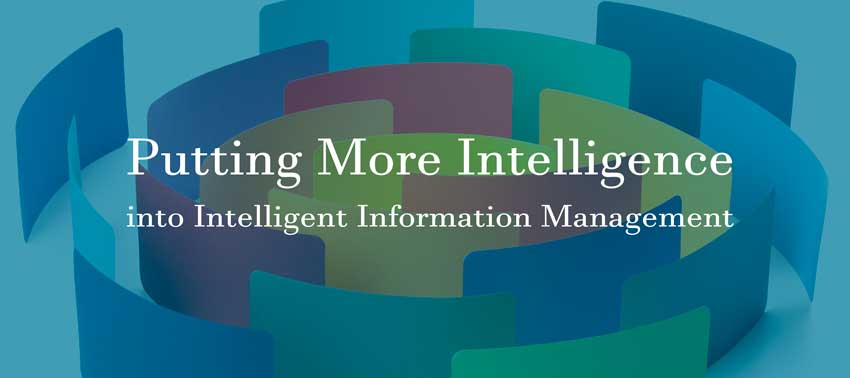PUTTING MORE INTELLIGENCE INTO INTELLIGENT INFORMATION MANAGEMENT
Claims processing service providers face a number of important challenges. Capturing data rapidly and efficiently with very high precision is essential. Throughout it all, providers must ensure ever higher levels of information governance, workflow automation and regulatory compliance.
Providers work to automate the data capture process, but the fact is they receive a great deal of input that falls outside of the scope of these augmented systems.
Providers work diligently to automate the data capture process. The aim is to eliminate manual intervention where possible, reduce errors and cut operating expense. Techniques like drop-out color scanning and other practices help streamline the process, but the fact is that service providers receive a great deal of input that falls outside of the scope of these augmented systems and is not optimized for data capture processing at all. Faxes are a prime example, as are photocopies (often copies of copies) and even photos from smartphones that all work together to sidetrack automation and derail the data capture process.
Imaging and Capture
The good news is that there are a number of advanced solutions available that can be used to optimize the capture of data and documents that fall outside the scope of your current automation. The quality of the image is fundamental to high-performing document automation, and there are often many problems that are encountered in production – skewed, blurry images and a lot of shifting and scaling are all commonly introduced by scanners and fax machines. This makes locating and capturing data more difficult and time consuming. Claims submitted without using drop-out forms result in very dense scans that are a problem for OCR and other data capture techniques. Enhanced capture and image processing work to correct image quality issues and apply things like de-skewing, de-speckling and more advanced features that work dynamically with a variety of image quality issues. The result is the elimination of a lot of costly and time-consuming data entry and verification.
Organization and Management
Service providers are also challenged to organize and manage all of the data and documents they capture. This is an especially pressing challenge for documents that are the exception to the rule and typically done “out of process.” These include a variety of supporting correspondence or other non-standard documents. It is important to have the ability to detect these documents early on, determine their importance and work to reduce or eliminate these exceptions. The ability to automatically recognize the different document types, where one particular document begins and ends, and how to identify and classify each one is essential for any attempt at process automation.
Today’s emerging solutions help accommodate these factors with a variety of advanced document analysis techniques that make organization and management of documents more immediate and automated. Advanced algorithms detect elementary objects like words or parts of words, separators, or codes that can be used to identify and classify document types, direct the workflow and automate the process.
Automated Workflow
Despite successful efforts to automate claims processing where possible, no technology automation is 100% perfect; and this leads to the need to have in-place processes to manage the exceptions. This may not be a big problem for high volume, highly predictable and optimized input, but it is a different challenge when the input is highly variant or subject to frequent change. The result is a workflow that requires a high degree of operator intervention, data entry and verification.
The confluence of machine learning and data capture allow organizations to design business rules for automation faster and with less human intervention than ever before.
The confluence of machine learning and data capture is a potent combination to combat these inefficiencies, allowing organizations to design and implement business rules for automation faster and with less human intervention than ever before. Using advanced document analysis techniques systems are smart enough to ‘read’ a batch of varied documents and build business rules around that analysis. Rather than create manual rules with human programmers, the system uses information gathered during the input and capture process to build rules automatically. Analysts are then free to refine as needed.
Moving Forward
What should you look for in a solution that will help you expand the scope of your current automation? When it comes to document capture, many fundamental capabilities are shared across solutions and do not provide any differentiation. Rather than focus on these primary capacities, look instead to a few key capabilities of modern document capture solutions that vary across vendors and how those differences map to the business requirements that you might have.
Here are some best-of-breed characteristics to look for:
- Advanced image processing capable of removing the”noise and garbage” from non-optimized input like faxes, photocopies and photographs.
- Document analyzation capabilities to automatically identify, classify and manage disparate document types.
- Machine learning features that allow the system to automatically design business rules for workflow automation and get data into the system sooner with minimal human intervention.
- Workflow analytics, accuracy reporting and the ability to prioritize and load-balance.
Claims processing service providers face important challenges: capturing data accurately and efficiently, organizing and managing that data in ways that are efficient and productive, and ensuring information governance and workflow protects privacy and compliance while minimizing operating expense. Use these factors and characteristics to determine the capture solution that best fits your organization’s needs. Look for providers and partners that provide the right mix of experience, vision and advanced capabilities that will help you make the most of advanced data capture for claims processing.
# # #
Guest contributor Kevin Craine is the author of the book Designing a Document Strategy and host of AIIM On Air, the podcast for AIIM International. He was named the #1 ECM Influencer to follow on Twitter. Find him at CraineGroup.com.
 Find out more about Parascript claims data extraction.
Find out more about Parascript claims data extraction.




